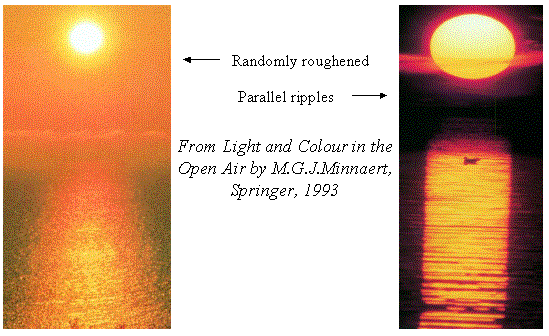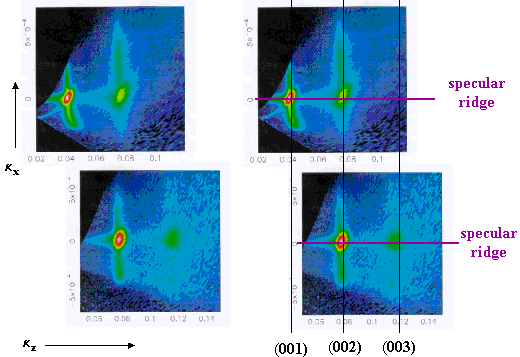
This is a long standing collaboration using neutron reflection to study adsorption of a range of systems at both air/liquid and solid/liquid interfaces. One of the limitations of specular reflection is that it only gives information about structure along the surface normal, nothing about the lateral structure. There is therefore much interest in systems which give rise to off-specular scattering because this would give information about the lateral structure. A simple illustration of this is shown in two pictures below. On the left is the mix of specular and off-specular reflection from randomly rough water and on the right the pattern is quite different because the ripples on the water are approximately parallel to each other.

The difficulty in neutron reflection is that the background scattering is usually greater than the off-specular reflection, so it is difficult to see. The surfactant AOT (see the first figure from Surfactants) forms a lamellar structure at concentrations not far above the critical micelle concentration with a repeat spacing of about 200 Å and this adsorbs at the surface to give a lamellar structure parallel to the surface, which is detected by the presence of strong diffraction peaks in the specular reflectivity. The most remarkable observation about the system is that it exhibits very strong off-specular reflection, shown below. In this diagram the axes have been changed from what is directly observed on the detector. The specularly reflected signal from the horizontal interface falls on the red horizontal line at Qx=0. The diffraction peaks from the aligned lamellar structure are equally spaced along the Qy direction. The streaks running vertically from the diffraction peaks and one streak coming out diagonally from the first peak are off-specular scattering. One interpretation of this scattering is that the individual AOT lamellae are either highly defective or rough (wavy) and their individual scattering is enhanced by diffraction effects to give a measurable signal. The origin of the diagonal line is not completely clear but it has been suggested that this is related to Newton's fringes with their origin in the roughness of the solid/AOT interface.

Jeff Penfold is at ISIS and another example of his work can be seen under Science:Chemistry on the ISIS website